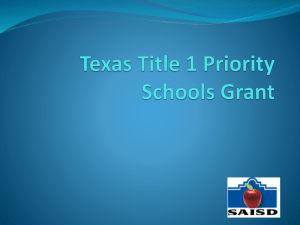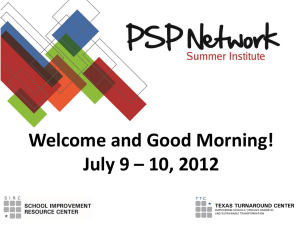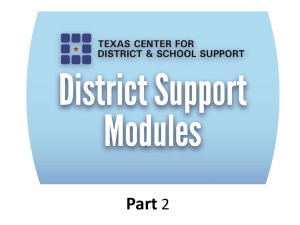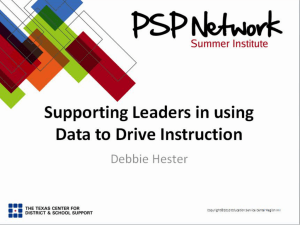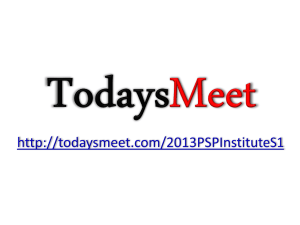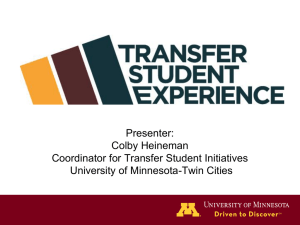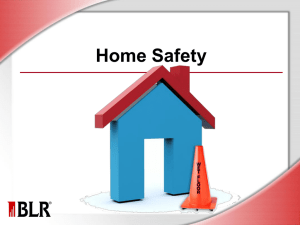Day 2 - Region 10 Education Service Center
advertisement
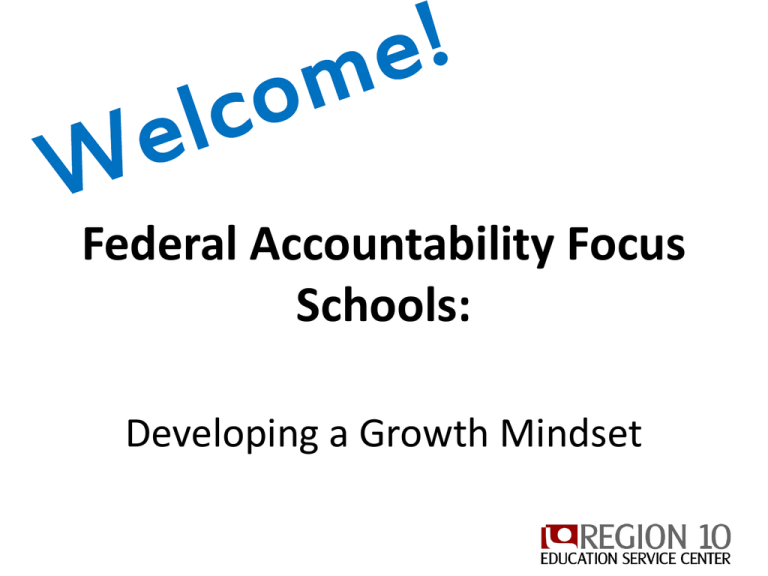
Federal Accountability Focus Schools: Developing a Growth Mindset Greetings, Meeting 1…review I. How Identified… and we This is a campuses reminder were that next week when meetrequired you willinterventions need to have complete a review of your safeguard data and have your highest II. TAIS Process overview area of need identified for your improvement plan and 1003a application. If you have any III. Identifying instructional interventions question please feel free to contact me IV. Tools, Resources, and Support Natosha Scott. I look forward to seeing you next week. Have a Happy Valentine’s Weekend. Agenda • ESEA Turnaround Principles and CSFs-A Deeper Look • Action Steps and Support Available • TEA-Funding Application and Updates https://todaysmeet.com/Region10focus OBJECTIVES Understand how the TAIS framework is the lens through which we do the work of the continuous improvement process. OBJECTIVES Identify each component of the continuous improvement process and key points to consider when planning. OBJECTIVES Interpret how the steps of the continuous improvement process can be used to develop an improvement plan that aligns to the CSFs and ESEA Turnaround Principles C Improve Academic Performance Increase the Use of Quality Data to Drive Instruction Increase Leadership Effectiveness Increase Learning Time Increase Family and Community Engagement Improve School Climate Increase Teacher Quality Provide strong leadership Ensure effective teachers Redesigned school calendar Strengthen the school’s instructional program Use data to inform instruction Improve school environment Ongoing family and community engagement Alignment Activity Critical Success Factors ESEA Turnaround Principles Reflective Questions What were your reflective thoughts/ideas that you had about your campus, staff, students or community as you were doing the alignment activity? What can YOU do now? Not what you THINK the data is telling you Step 1: Individually, read the 1st question. Step 2: In your own words, make note of what the question is asking. Step 3: Go around the table and share your responses one at a time. Step 4: Look at example 1 & 2 and discuss how each response addresses the question asked. What does the data reveal about the trends and patterns over time? Step 1: Individually, read the 2nd question. Step 2: In your own words, make note of what the question is asking. Step 3: Go around the table and share your responses one at a time. Step 4: Look at example 1 & 2 and discuss how each response addresses the question asked. What is the impact of the trends and patterns? Step 1: Individually, read the 3rd question. Step 2: In your own words, make note of what the question is asking. Step 3: Go around the table and share your responses one at a time. Step 4: Look at example 1 & 2 and discuss how each response addresses the question asked. What other insights does the data reveal? Not what you THINK the data is telling you “Instruction” “Student Achievement” “Instruction” “Teachers lack the skills to plan lessons relevant to the interests of the students.” Step 1: What need did the data reveal at your campus? Step 2: What Turnaround Principle (TP) or Critical Success Factor (CSF) does this need correspond to? Step 3: Does everyone agree that this is the need that will best help you close the achievement gap? Step 4:Write the need on sentence strip, and post appropriately. Improvement Planning www.youtube.com/watch?v=WwP_tXXqx_M ©2013 TCDSS • Assess readiness for planning Step 2 • Establish priorities • Align to core values Step 3 • Backwards plan • Set annual goals • Dissect annual goals to determine strategies and interventions Step 5 • Evaluate and make adjustments to the plan Annual Goals S M A R T Specific Measurable Attainable Results-based Time-bound “94%” “Decrease time out of classroom instruction” “75% of all students will meet growth expectations for index 2 in mathematics” SPECIFIC Vital few”-high leverage areas where largest gaps between vision and current reality exist; therefore, greatest gain will be seen •“ •Align goals as a system when possible (district campus classroom) •Specificity provides concrete, tangible evidence of improvement that teachers teams need to stay motivated •Should be specific to skills or student groups MEASURABLE •Schools should focus on summative measures •Teachers at classroom level should focus on both summative and formative measures •Schools should review measures one or more times a year to see if they are on track •Teachers need frequent, ongoing views of how students are performing to assess learning and provide feedback ATTAINABLE •Goals must be attainable •Goals motivate us to strive higher require to stretch in order to achieve. Attainability = (How large the gap) x (how much focus, energy, time, and resources you’re prepared to put in RESULTS-BASED •Focus on GAN (greatest area of need) •Overall amount of improvement desired TIME-BOUND •Builds internal accountability and commitment. THE GOAL SMART GOAL INDICATORS •Evidence we look at to determine if goal is being achieved; standard/benchmarks that students have previously performed poorly on in the GAN •Improving that area should help improve other areas SMART GOAL INDICATOR (Area/objective of weakness that must be addressed to achieve goal) MEASURES •Assessment you will use to gauge progress on indicators. SMART GOAL INDICATOR MEASURES TARGETS •Establish improvement targets for each measure to track improvement (as a whole or subgroup). •How much growth is needed to meet the goal. SMART GOAL INDICATOR MEASURES TARGETS •If goals are set by a team, common assessments should be used as a measure. •If goal is set by teacher, targets would be within shorter time frames and focus on improving student’s level of performance. SMART GOAL PROCESS 1. Identify and verify needs (data review) 2. Identify and create SMART Goal (goal, indicators, measures, and targets) 3. Determine best practices to address GAN and meet goal (instructional strategies) 4. Plan professional development if needed 5. Analyze results and refocus HANDOUT ORIGINAL “Increase academic performance with a percentage of students meeting passing performance of 80% or greater.” REVISED “By the end of the 2014-2015 school year, 9th grade reading performance will increase from 70% to 80% as measured by CBAs.” So far… Gaps in Data (Problem statement) Annual Goal Link to the need to achieve the annual goal Are research based Are broad and overarching Increase efficiency in teaching and learning Provide overall direction When selecting strategies… Selecting strategies… “Data driven decisions will be made” “Address student group needs that will ensure mastery of all standards required.” HANDOUT “Utilization of Professional Learning Communities” “Increase capacity of teachers by utilizing differentiated instruction in the classroom ” “Tie awards and incentives to positive academic interventions” Annual Goal Strategy QUARTERLY QUARTERLY GOALS Short-term Results-based Implementation of the strategy Support the annual goal HANDOUT STRATEGY: Utilization of Professional Learning Communities ANNUAL GOAL: “By the end of the 2014-2015 school year, 9th grade reading performance will increase from 70% to 80% as measured by CBAs.” INTERVENTION Steps to achieve quarterly goal Specific actions for implementation Collecting data on intervention HANDOUT Are you on track to meet the ANNUAL GOAL? 1 Describe the type of data used .2 to determine if the goal will or will not be met. .. What, if any, adjustments must 3 be made in order to meet the ANNUAL GOAL? ESEA Turnaround Principles and Critical Success Factors...a deeper look Sample aligned interventions • Think in terms of your campus • Have someone record major thoughts • Be prepared to share Providing Strong Leadership http://www.tcdss.net/ttips/leadershipeffectiveness.html Redesigning the school day, week, or year to include additional time for student learning and teacher collaboration http://www.tcdss.net/ttips/learningtime.html Strengthen the School’s Instructional Program http://www.tcdss.net/ttips/academicperformance.html Using data to inform instruction and for continuous improvement, including by providing time for collaboration on the use of data http://www.tcdss.net/ttips/qualitydata.html Establishing a school environment that improves school safety and discipline and addressing other non-academic factors that impact student achievement http://www.tcdss.net/ttips/schoolclimate.html Provide ongoing mechanisms for family and community engagement http://www.tcdss.net/ttips/familycommunity.html Ensuring teachers are effective and able to improve instruction http://www.tcdss.net/ttips/teacherquality.html • On paper, and without speaking to anyone…brainstorm most effective instructional interventions for your identified need. • Share your list with your campus partners. • Choose one intervention and write on second sentence strip • Post intervention under the need you posted this morning Items to Cover… • • • • • Focus Schools Funding and Resources Title I, 1003(a) Priority and Focus school grant Q&A TEA Contact Information 2013-14 Focus Schools 2013-14 Focus Schools • 598 Focus schools – Ranked by the widest gaps between reading/math performance of the 7 federal student groups and safeguard targets of 75% 2013-14 Focus Schools • 2013-14 Focus school list in effect for 3 years • Please contact our office when choosing to Not Serve an identified campus with Title I funds 2013-14 Focus Schools • Currently researching and developing Exit Process for schools making significant progress for two consecutive years following interventions and who no longer fit the criteria to be identified as a focus school Funding and Resources Funding and Resources • No carry-over from 2012-13 unspent School Improvement Program (SIP) funds • Title I, 1003(a) Focus school grant funding is a combination of unspent 2012-13 and 2013-14 funding Funding and Resources • Funding provided to Education Service Center (ESC) Turnaround Teams for support to Focus Schools to: – deliver on-going and continuous support around the Texas Accountability Intervention System (TAIS) – review with the campus the ESEA turnaround principles and Critical Success Factors (CSFs) – assist the campus and district in identifying, implementing and including in the 2013-14 campus improvement plan, no less than one instructional intervention targeted to meet the deficiencies of the campus and assist in closing existing achievement gaps Funding and Resources • End of year reporting from ESCs to TEA on services provided to Focus Schools • End of year reporting from LEAs to TEA on ESC services provided to Focus Schools Title I, 1003(a) Focus school grant Title I, 1003(a) Focus School Grant Application – Scheduled to open in eGrants on February 13, 2014 – Closing date in eGrants March 17, 2014 – Amendment deadline June 16, 2014 – Grant ends on September 30, 2014 Allocations – Non-TTIPS Priority Schools $161,000 – Focus Schools $20,000 Title I, 1003(a) Focus School Grant Pre-award – No pre-award attachment – Line item in Part 7 of BS6004 – Pre-award costs are allowable from December 12, 2013 for registration and travel costs to TEA required trainings only NOGA for Grant will have 2 lines – 2014 allocation – 2013 amount added from unspent 2012-2013 SIP funds – will be labeled 2013 carryover – Amount labeled 2013 carryover must be spent by 9/30/14 Title I, 1003(a) Focus School Grant Allowable Costs In Program Guidelines – Reasonable and necessary to carry out grant – Supplement, not supplant – even to Title I, Part A – Needs identified in Campus Needs Assessment and/or Improvement Plan – Guidelines posted on Grants Administration Link Title I, 1003(a) Focus School Grant • PS3010 – Priority OR Focus School • Campus Identification • Open Enrollment Charter School • Identified as Improvement Required (IR) • Planned Expenditures and Action Plan – Provide a summary of each activity planned to address the required principle OR goal Title I, 1003(a) Priority and Focus School Grant Focus Planned Expenditures and Action Plan Each goal must be addressed • Decrease the school’s widest gaps between the seven federal student subgroups in reading/math performance • Meet Annual Measurable Objective (AMO) targets of 75% or higher for the seven federal student subgroups Title I, 1003(a) Priority and Focus School Grant • Focus Planned Expenditures – Provide a summary of the activities for each goal – Provide the estimated percentage of funds to be used to carry out the planned activities – 1% minimum • LEA level activities (Optional) – Provide a summary of the LEA level activities for each goal – Provide the estimated percentage of funds to be used to carry out the planned activities – 40% maximum – Must total 100% Question and Answer Q: A: I would like to pay my PSP with these funds. Is that allowable? Professional Service Providers (PSP) are not required for Priority and Focus schools. A school may contract with a person to assist the campus in meeting the intent and purpose of the grant. Q: A: Why does my NOGA have 2 lines? One line is for 2012-13 funds and the other is for 2013-14 funds. Q: A: Will pre-award be allowed? Yes. Pre-award will only be allowed for travel to the required trainings that occur prior to this application being submitted through eGrants. Q: A: How much must I spend before September 30, 2014? Priority schools approximately 54% Focus schools approximately 50% Q: What are the timelines associated with this grant application? A: Open in eGrants – February 13, 2014 Deadline in eGrants – March 17, 2014 Amendment Deadline – June 16, 2014 NOGA ends – September 30, 2014 Q: A: Will any funds roll forward into 2014-15? Yes. Unspent 2013-14 funds will roll forward. Q: A: May we expend all Priority/Focus funds at the LEA level? No. There is a 40% maximum limit of funds to be spent at the LEA level. Q: What are allowable expenses? A: Allowable costs are: - Reasonable and necessary to carry out grant (turnaround principle or goal); - Supplement, not supplant – even to Title I, Part A; - Follow Guidance on Grants Administration Links: Federal Cost Principles Side-by-Side, Updated 06-17-2013 (PDF 705 KB) and TEA Guidelines Related to Specific Costs, Updated 06-03-2013 (PDF 447 KB); - Identified need through Campus Needs Assessment; - Salary only if justified and then no more than 30%; - No more than 75% combined budgeted in object codes 6300 (Supplies and Materials) and 6600 (Capital Outlay) Contact Information Division of School Improvement and Support Leticia Govea (512) 463-1427; leticia.govea@tea.state.tx.us Becca Marsh (512) 936-2256; becca.marsh@tea.state.tx.us Shayna Sheehan (512) 463-2617; shayna.sheehan@tea.state.tx.us Lisa Gonzales (512) 463-3246; lisa.gonzales@tea.state.tx.us Nicole Chupka (512) 936-2142; nicole.chupka@tea.state.tx.us

